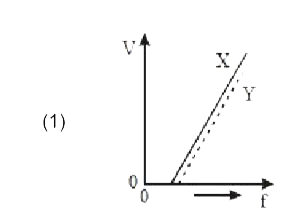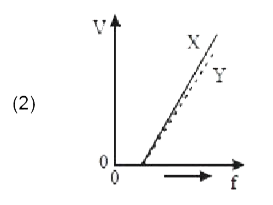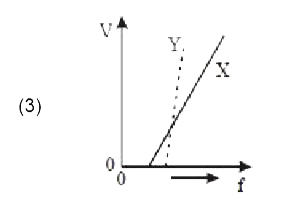The military wants to build a device for com-munication at ultrasonic frequencies.
At which of these frequencies should the device work to meet the military 's requirements ?
25 Hz
220 Hz
10116 Hz
32842 Hz
The correct Answer is:d
To determine the frequency at which the military's communication device should operate to meet their requirement for ultrasonic frequencies, we can follow these steps:
Step 1: Understand the Categories of Sound Frequencies
Sound frequencies can be classified into three main categories:
- Infrasonic Frequencies: Frequencies less than 20 Hz (not audible to humans).
- Audible Frequencies: Frequencies between 20 Hz and 20,000 Hz (audible to humans).
- Ultrasonic Frequencies: Frequencies greater than 20,000 Hz (not audible to humans).
Step 2: Identify the Requirement
The military requires a device that operates at ultrasonic frequencies. This means the frequency must be greater than 20,000 Hz.
Step 3: Evaluate the Given Options
We need to evaluate the provided frequency options to see which one falls into the ultrasonic category:
1. 25 Hz: This is in the audible range (20 Hz to 20,000 Hz).
2. 220 Hz: This is also in the audible range.
3. 10,116 Hz: This is still within the audible range.
4. 32,842 Hz: This frequency is greater than 20,000 Hz, placing it in the ultrasonic range.
Step 4: Conclusion
Among the options provided, the only frequency that meets the requirement for ultrasonic communication is 32,842 Hz.
Final Answer
The device should work at 32,842 Hz to meet the military's requirements for ultrasonic communication.
---
Sound frequencies can be classified into three main categories:
- Infrasonic Frequencies: Frequencies less than 20 Hz (not audible to humans).
- Audible Frequencies: Frequencies between 20 Hz and 20,000 Hz (audible to humans).
- Ultrasonic Frequencies: Frequencies greater than 20,000 Hz (not audible to humans).
The military requires a device that operates at ultrasonic frequencies. This means the frequency must be greater than 20,000 Hz.
We need to evaluate the provided frequency options to see which one falls into the ultrasonic category:
1. 25 Hz: This is in the audible range (20 Hz to 20,000 Hz).
2. 220 Hz: This is also in the audible range.
3. 10,116 Hz: This is still within the audible range.
4. 32,842 Hz: This frequency is greater than 20,000 Hz, placing it in the ultrasonic range.
Among the options provided, the only frequency that meets the requirement for ultrasonic communication is 32,842 Hz.
The device should work at 32,842 Hz to meet the military's requirements for ultrasonic communication.
Topper's Solved these Questions
- SOUNDBook:PEARSON IIT JEE FOUNDATIONChapter:SOUNDExercise:CLASSROOM CORNER C . Long Answer Type Questions
Explore 13 Videos
- MOCK TESTBook:PEARSON IIT JEE FOUNDATIONChapter:MOCK TESTExercise:MULTIPLE CHOICE QUESTIONS
Explore 25 Videos
- SOURCES OF ENERGY Book:PEARSON IIT JEE FOUNDATIONChapter:SOURCES OF ENERGY Exercise:Concept Application (Level 2)
Explore 20 Videos
Similar Questions
Joseph wants to pick the iron nails kept on a table.

Which of the following devices should Joseph use to pick the iron nails?
View SolutionBats navigate and search out prey by emitting, and then detecting reflections of, ultrasonic waves, which are sound waves with frequencies greater than can be heard by a human. Suppose a bat emits ultrasound at frequency fbe = 82.52 kHz while flying with velocity →vb=(9.00m/s)ˆi as it chases a moth that flies with velocity →vm=(8.00m/s)ˆi. What frequency does the moth detect? What frequency fmd does the bat detect in the returning echo from the moth?
View Solution
Knowledge Check
A 1MHz carrier signal is modulated by a symmertrical sinusoidal wave for period of 100μs in a nonlinear (square lae device).Which of the following frequencies will notbe present in the modulated signal
A990kHzB1010kHzC1020kHzD1030kHzA parallel beam of light is incident on a tank filled with water up to a height of 61.5 mm as shown in the figure below. Ultrasonic waves of frequency 0.5 MHz are sent along the length of the water column using a transducer placed at the top, and they form longitudinal standing waves in the water. Which of the schematic plots below best describes the intensity distribution of the light as seen on the screen ? Take the speed of sound in water to be 1,500 m/s.
 A
A B
B C
C D
D
In a photoelectric emission, electrons are ejected from metals X and Y by light of frequency f. The potential difference V required to stop the electrons is measured for various frequencies. If Y has a greater work function than X, which graph illustrates the expected results.
A B
B C
C D
D
A flute which we treat as a pipe open at both ends is 60cm long. (a) What is the fundamental frequency when all the holes are covered? (b) How far from the mouthpieces should a hole be uncovered for the fundamental frequency to be 330HZ ? Take speed of sound in air as 340m/s.
View Solution(i) A harmonic wave in a stationary medium is represented by y=asin(kx–ωt). Write the equation of this wave for an observer who is moving in negative x direction with constant speed v0.
(ii) The Doppler flow meter is a device that measures the speed of blood flow, using transmitting and receiving elements that are placed directly on the skin. The transmitter emits a continuous sound wave whose frequency is 5MHz. When the sound is reflected from the red blood cells, its frequency is changed in a kind of Doppler effect. The cells are moving with the same velocity as the blood. The receiving element detects the reflected sound, and an electronic counter measures its frequency, which is Doppler- shifted relative to the transmitter frequency. From the change in frequency the speed of the blood flow can be determined. Typically, the change in frequency is around 600Hz for flow speeds of about 0.1m/s. Assume that the red blood cell is directly moving away from the source and the receiver. (a) Estimate the speed of the sound wave in the blood?
(b) A segment of artery is narrowed down by plaque to half the normal cross-sectional area. What will be the Doppler change in frequency due to reflection from the red blood cell in that region?
View SolutionSketch the graphs, showing the variation of stopping potential Vs with frequency v of the incident radiations for two photosensitive materials A and B having threshold frequencies v0>v'0 respectively.
(i) which of the two metals A or B has higher work function?
(ii) What information do you get from the slope of the graphs?
(iii) What does the value of the intercept of graph A on the potential axis represent?
View SolutionDefence expenditure is an important component of national security and every country allocates a significant portion of its resources for this purpose. However, given the scarcity of resources and the competing demands from other sectors, a nation’s ability to meet all its Defence requirements is not unlimited. Even the United States, the only military superpower, is unable to afford many of its major programmes, forcing it to scale down the number of items to be procured. The sheer size of the Defence budget and its impact on other sectors of the economy thus, more often raises the question as to how much a country can afford for its Defence. In the absence of any clear framework of evaluating affordability of Defence spending, many analysts tend to view the same from the perspective of a country’s share of Defence in gross domestic
product (GDP) over a period of time, or by comparing these shares with those of other countries. This method of relative measurement, however, suffers from ambiguities as it does not take into account a country’s specific security concerns and the economic compulsions in its totality. In the global context, the affordability of military spending of some of the world’s major military spenders varies not only in degree but also from time to time. While the variation in the degree of affordability indicates the changing security threats that are perceived differently by countries, the fluctuation in affordability over time points to the fact that what may be affordable at one point in time, may not be so at another time. Among the major powers, except for Japan, no other country has been able to sustain consistently high level of Defence spending (in percentage of GDP) over a length of time. The macro economy, which guides major spending heads of the government, could be a factor in controlling Defence spending over a period of time. In the US, the present level of military spending has contributed to fiscal distress, raising doubts whether such large-scale military spending is affordable or sustainable in the future. Source:
https://idsa.in/jds/2_1_2008_IndiaAffor dableDefenceSpending_LKBehera
What does the author mean by “...a nation’s ability to meet all its Defence requirements is not unlimited.”?
View SolutionDefence expenditure is an important component of national security and every country allocates a significant portion of its resources for this purpose. However, given the scarcity of resources and the competing demands from other sectors, a nation’s ability to meet all its Defence requirements is not unlimited. Even the United States, the only military superpower, is unable to afford many of its major programmes, forcing it to scale down the number of items to be procured. The sheer size of the Defence budget and its impact on other sectors of the economy thus, more often raises the question as to how much a country can afford for its Defence. In the absence of any clear framework of evaluating affordability of Defence spending, many analysts tend to view the same from the perspective of a country’s share of Defence in gross domestic
product (GDP) over a period of time, or by comparing these shares with those of other countries. This method of relative measurement, however, suffers from ambiguities as it does not take into account a country’s specific security concerns and the economic compulsions in its totality. In the global context, the affordability of military spending of some of the world’s major military spenders varies not only in degree but also from time to time. While the variation in the degree of affordability indicates the changing security threats that are perceived differently by countries, the fluctuation in affordability over time points to the fact that what may be affordable at one point in time, may not be so at another time. Among the major powers, except for Japan, no other country has been able to sustain consistently high level of Defence spending (in percentage of GDP) over a length of time. The macro economy, which guides major spending heads of the government, could be a factor in controlling Defence spending over a period of time. In the US, the present level of military spending has contributed to fiscal distress, raising doubts whether such large-scale military spending is affordable or sustainable in the future. Source:
https://idsa.in/jds/2_1_2008_IndiaAffor dableDefenceSpending_LKBehera
Which of the following is either a synonym or an antonym of the highlighted word used in the passage?
AMBIGUITIES
I. Equivocations
II. Luminosities
III. Transparencies
View Solution